Graphium angolanus is another butterfly that, due to having the same general type of wings as the White Lady Swallowtail, has been called a White Lady. Its wings are white, but with wide borders of black, brown, or red dotted with white, and its body is mostly black.. It is found in many parts of sub-Saharan Africa and is named for the country called Angola.
Photo from Reiman Gardens. The color is black or nearly black above...
Photo by Oddb in Benin. The colors are dark brown, yellowish brown to orange, and reddish brown to red, below. Only about half of each side of each wing is plain white. Some observers call it a black butterfly with white spots.
And while the genus as a whole is sometimes called the Swordtail, this--showing about as much as Graphium angolanus ever show in the way of "swallow tails"--,might be called nail-scissors-tails. Photo by Stefaneakame, taken in Yaounde, Cameroon, in July.
If the scientific name currently seems simple and straightforward, it was arrived at after no less than 21 other names had been used for this species (or some of it). All the Swallowtail-type butterflies were originally placed in the one genus Papilio, so it was Papilio angolanus and P.a. spoliatus. It was also called Papilio or Graphium pylades, a name that is still sometimes used, and P. corinneus and P. anthemenes. Each of those names fitted into the tradition of naming Swallowtails after characters in ancient literature, but angolanus had been recorded first. Several variant forms used to be listed as subspecies of Papilio pylades. Finally, this butterfly was also named Graphium calabar. The species name pylades has been used recently enough to be found on the Internet, but mostly on lists, sites that claim to sell butterfly carcasses, and pages that redirect to the species name angolanus. Pylades has been placed on an Official List of Rejected Species Names. And now some want to break up the genus Graphium and call this species Arisbe angolanus. And some quibblers about a fine point in Latin grammar say it should be angolanum.
Proposed subspecies names addenda, anthemenes, blariauxi, calabar, corineus (corinneus), dawanti, deficiens, houzeaui, howelli, hypochroa, jottrandi, jouani, kitungulua, lapydes,pylades, spoliatus, and wansoni have gone out of use; they appeared to describe individual variations rather than distinct subspecies, and some of the variations seemed to belong to other species anyway.
Graphium angolanus is popular enough to appear in arts and crafts:
(You can buy a kit to cross-stitch this design onto a refrigerator magnet: https://embroidery-kits.com/products/e/4/9/bat25-belaya-ledi-angoli-graphium-angolanus-magnit-artsolo-nabor-almaznoy-zhivopisi.html. I'm not sure why the crafter chose to show the underside in a wing-spread view, which is usually seen only when the butterfly is dead, but it's certainly more attractive than a box of dead butterflies.)
(Or make this bead brooch: https://sova-enterprises.com/catalog/product_info.php?products_id=19319.)
You can buy photos of these butterflies as wall art, too. Artflakes.com has a photo I found striking enough that I tried to include a small image and a link here, but since the site blocked copying the photo I see no need to include the link. But it's on the site if you look.
It is one of several species that are classified in the Swallowtail family, because of the general shape of their wings, although only a few of them show even vestigial tails. With that extension on their fore wings, their wingspan is up to three inches. Females are more likely to reach the full three inches than males are. A few sources document measuring individuals over three inches, but not so much as three and a half.
This species flies all through the year, with most activity in November and February. Caterpillars can eat the leaves of wild plants in any of four genera: Annona, Landolphia, Sphedamnocarpus, or Uvaria; but of every species in any genus. Friesodielsia obovata and Hexalobus monopetalus are also reported as host plants.
The caterpillars are known to like Annona senegalensis, the Senegal custard-apple, whose fruit humans eat. It is said to taste like a mix of pineapple and apricot. In some places people have even been hungry enough to eat the leaves and flowers of this plant. They have been known to perceive the butterflies as competitors for scarce food resources and spray poisons on the bushes, probably doing themselves more harm than they do the butterflies in the long run. (Actually, although caterpillars do eat leaves, they repay the plants when they grow up to serve as pollinators. I'm not finding reports that Annona senegalensis has alternative pollinators or could survive without these butterflies; many American Annonaceae are totally dependent on their Kite Swallowtail symbionts to survive.) Though the plants and butterflies do well together in the wild state, in every part of the continent where the soil and climate support them, they are said to be hard to rear in commercial farm conditions. It may be crucial to the reportedly delicious custard-apple's survival that people learn not to spray poisons on this plant.
Photo by Micoltanzania, from (no points for guessing) Tanzania. Adult butterflies pollinate several kinds of flowers.
There are two subspecies, Graphium angolanus angolanusi, found in the southern corner of the continent (Angola, Botswana, Comoros, the Democratic Republic of the Congo, Eswatini, Kenya, Malawi, Mozambique, Namibia, South Africa, Tanzania, Zambia, Zimbabwe), and G.a. baronis, found northward, closer to the equator (Benn, Burkina Faso, Burundi, Cameroon, Central African Republic, Chad, Congo, Democratic Republic of the Congo, Ethiopa, Gambia, Ghana, Guinea, Guinea-Bissau, Ivory Coast, Kenya, Mali, Niger, Nigeria, Rwanda, Sao Tome & Principe, Senegal, Sierra Leone, Sudan, Tanzania, Togo, Uganda). The name of Baronia brevicornis commemorates a naturalist called Baron, but the name of Graphium angolanus baronis commemorates a place in Ethiopia called Baro.
For those who travel, a short but relevant link: There's more to Nigeria than e-mail scams. Though a friend who went there said "I don't mind paying twice as much as a local person pays for the same thing, but they asked for twenty times as much." They do love those funny old greenish pictures of our famous buildings and people.
Photo by Tonyking. The northern subspeies, Graphpium angolanus baronis, are good at finding water in dry country.
Photo by Glynlewis, from Zambia. The southern subspecies, Graphium angolanus angolanus, can have bright amber rather than brown patches on the underside and on the abdominal section of the body.
Graphium angolanus looks very similar to what are currently classified as five other species: Graphium endochus, morania, ridleyanus, schaffgotsi, and ridleyanus.
Generally, this species is not believed to be in any danger. It is not rare, and often forms or joins large flocks of its own species and others at shallow puddles. However, in Guinea, Togo, and Angola, habitat destruction, "pesticide" spraying, warfare, and excessive carcass "collecting" threaten local populations enough that the species has been listed as endangered.
It does not migrate regularly, but group migrations of Graphium angolanus alone, or with other species, are recorded. Generally it prefers to live near woods where females can find host plants for their eggs; males follow females. Unmated males also like to claim territories at the tops of ridges, and also, of course, gather at puddles where they are most easily photographed. (Males and females look pretty much alike; in some photos of couples one is clearly larger and shows less color contrast, in some there's no clear distinction.) The search for food and water may bring it into grassy fields.
It is considered a bold species, often flying at human eye level and sometimes willing to pose for selfies with humans. (Probably it likes the salt taste of sweat.) Its boldness may be due to mimicry. Though not highly toxic to birds, it resembles a more toxic species called the Black Friar, which is thought to be "related to" our Monarch, enough that birds tend to leave it alone.
The star of this short video is probably bolder than most individuals. No butterfly species could be this bold and survive. This little fellow is trying out for the "Jackass" show.
I didn't even see whether any other butterflies were watching and being impressed, though males of this species do seem to show off to impress one another with their boldness. They're one of the species that play "chicken" with one another and fly at people entering what they're claiming as territory.
It's all part of the mating cycle. They mate back to back, side to side, or some compromise between the two, but there's a set of web sites that claim to be about "flowers of" various African countries and then show pictures of this species mating aerobatically, as they sometimes do, with one butterfly hanging upside down from the other, holding on by some of the mysterious internal parts of the tail tip. You'll find those if you search. I'm not sure I want to reward them with links. A photo of butterflies mating amidst other photos of butterflies doing their thing is useful for illustrating differences, if there are any, between male and female wing patterns, but a site that only shows pictures of butterflies mating would have to be called butterfly pornography. We don't endorse porn!
This one, feeding more normally from a sponge in a dish of sugar-water, is joined by a couple of Clearwings.
Anyway, butterflies find mates and lay eggs. Eggs are placed by ones on the upper sides of leaves the caterpillar will be able to eat. They are greenish white and have the usual Swallowtail bead shape.
Hatchlings are brown with four pairs of harmless bristles, three along the hump behind the head, two at the rear. They immediately eat the shells from which they hatched, then proceed to gnaw small holes in leaves, doing little damage to the host plants.
In the first molt they acquire a brown, yellow, and white pattern.
Photo by Leani. The last caterpillar skin is light green with a few subtle markings. Only mildly toxic to most predators and about two inches long, it needs to be well camouflaged, and it is. It has a squared-off, almost conic shape with its humped back concealing a green osmeterium. It takes only about two weeks for the caterpillars to reach this relatively large and hungry stage, during which they eat whole leaves. Fortunately there's only one to a plant or tree limb, so the host plant can usually afford their depredations.
Photo by Magdastlucia, taken in South Africa. The pupa looks like a stiff, brittle leaf with two horns at the top and a "keel" ridge down one side.








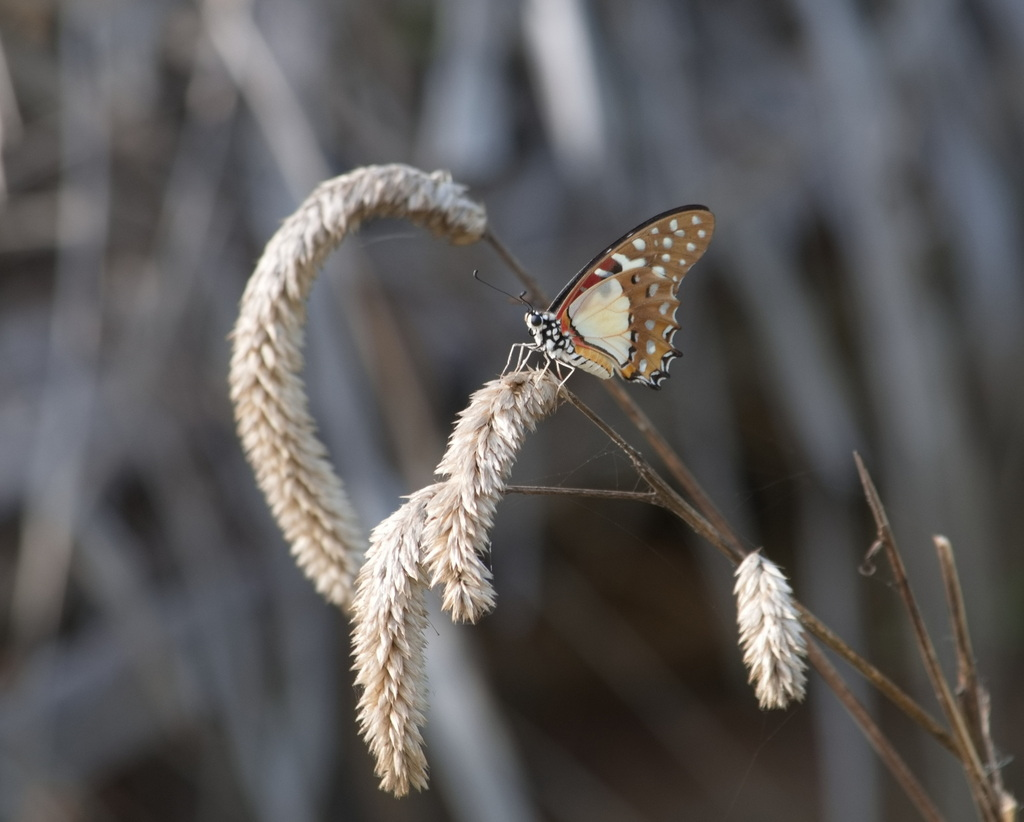
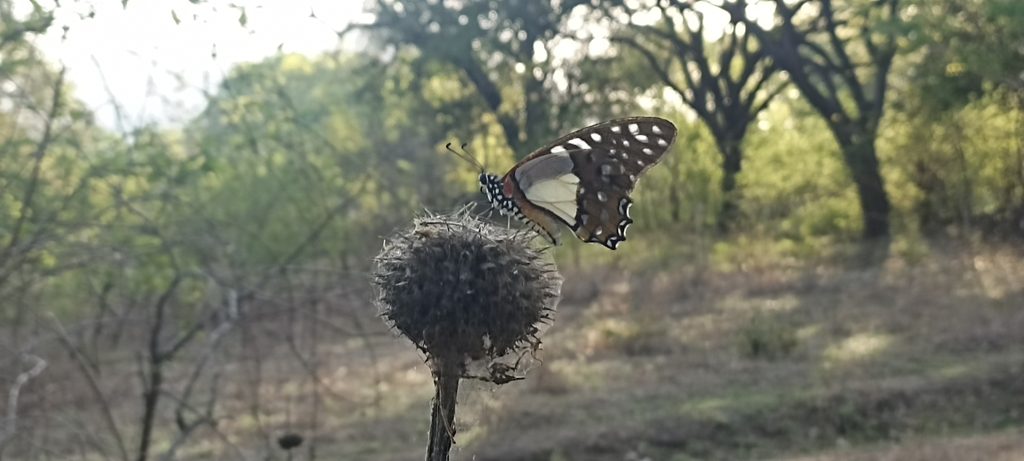

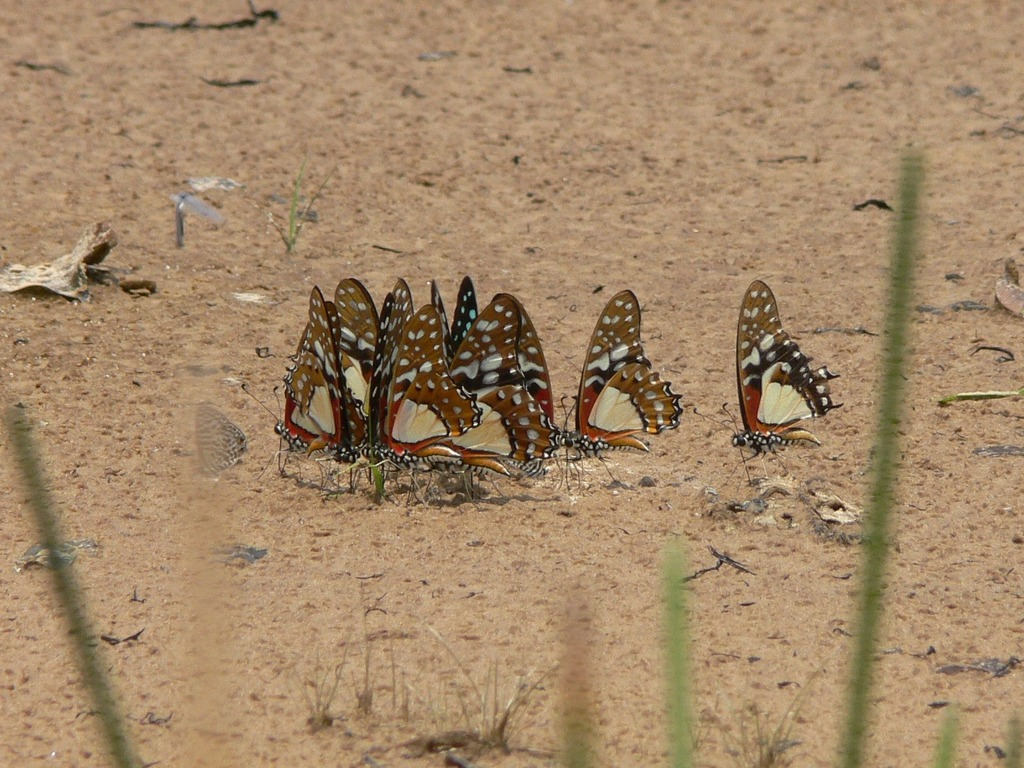
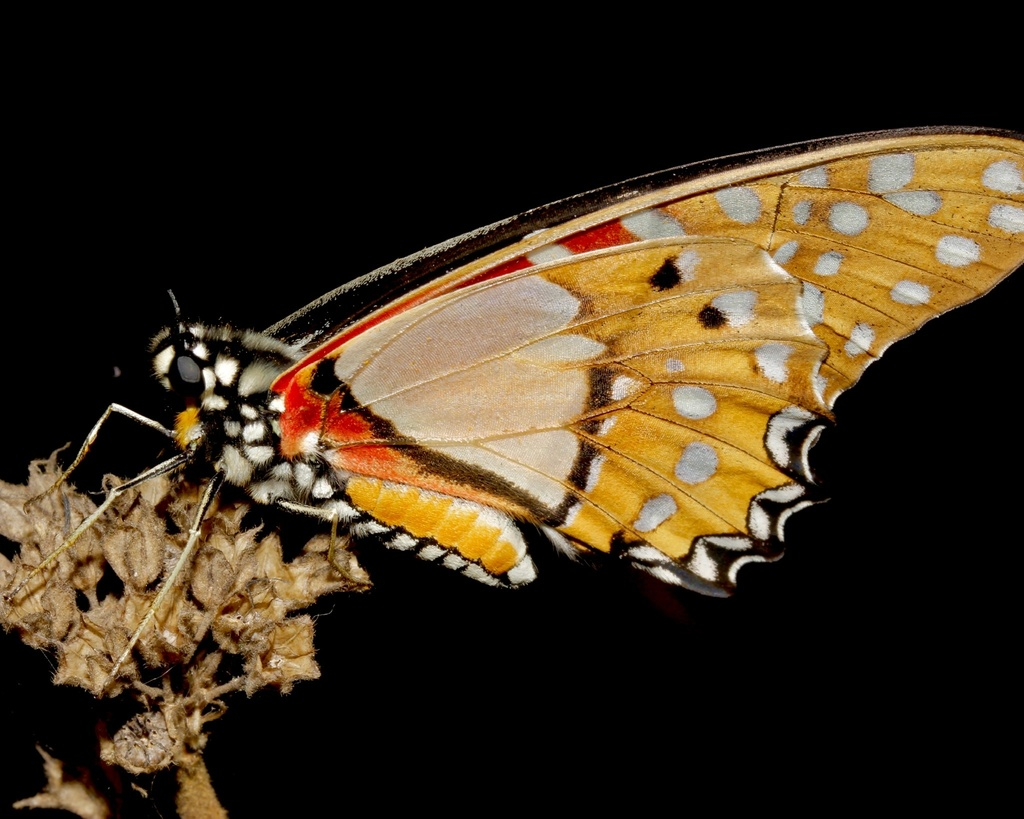

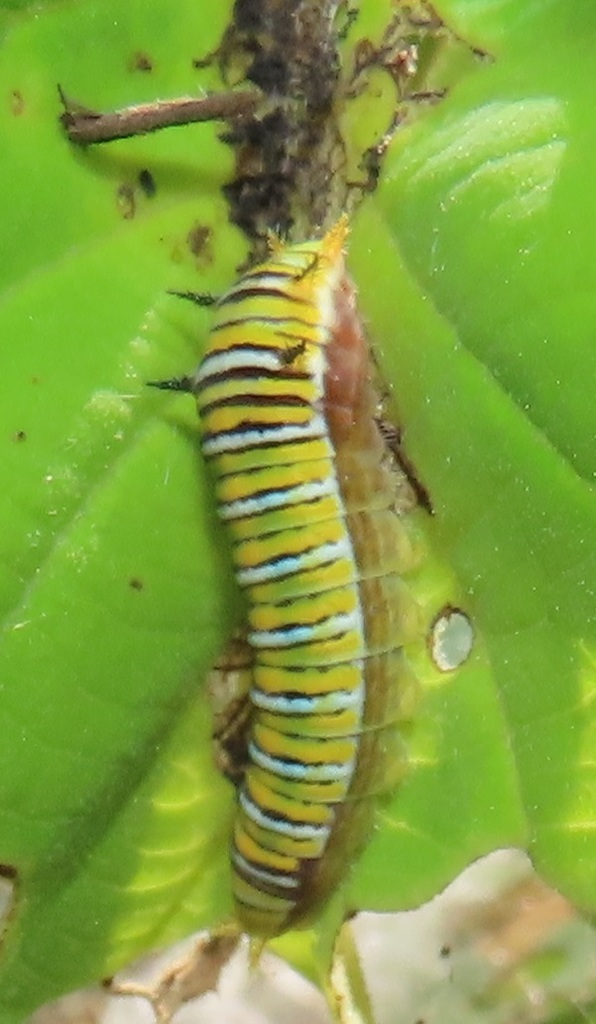
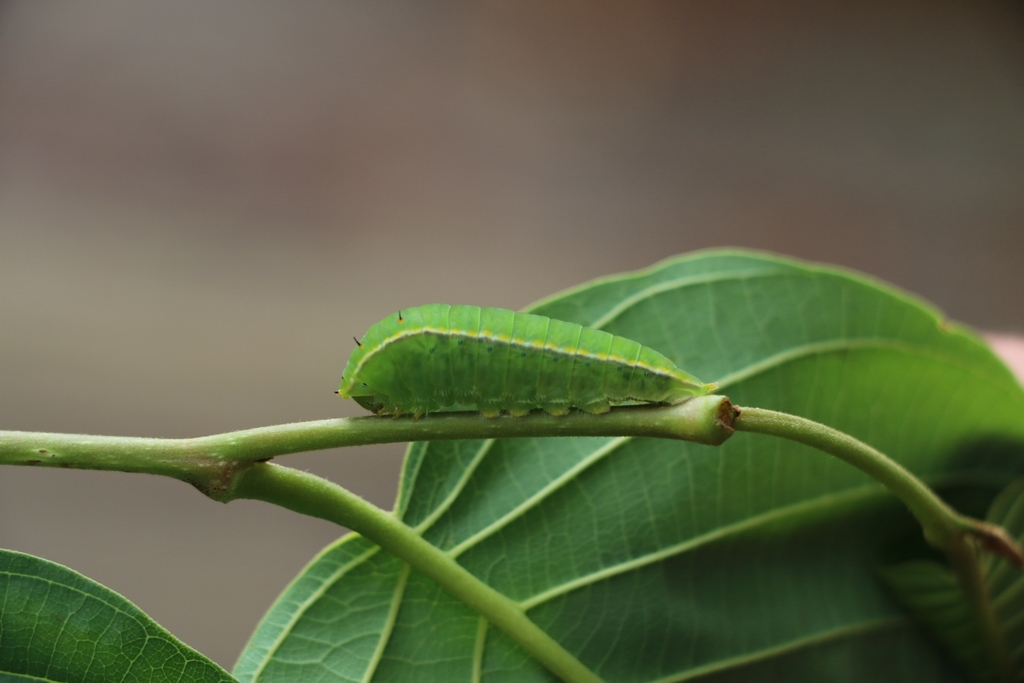


No comments:
Post a Comment